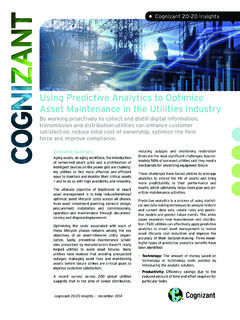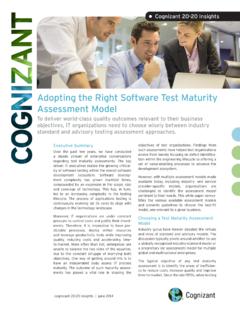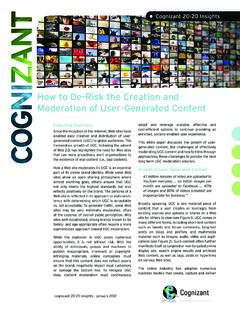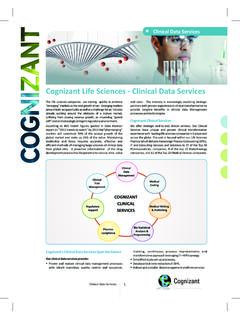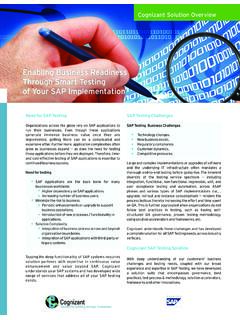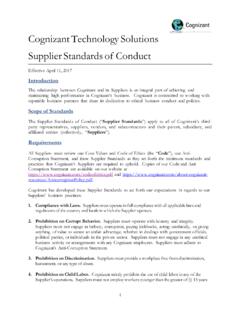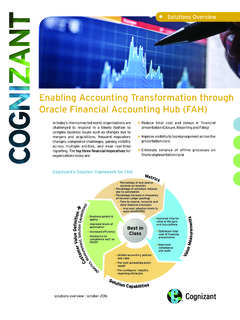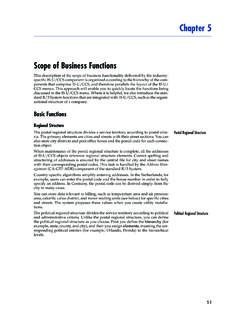Transcription of CIS Transformation: Unlocking the Value of Utilities ...
1 cis transformation : Unlocking the Value of Utilities Customer Information Systems To remain competitive amid continuing economic uncertainty and regulatory change, Utilities must accelerate the replacement of inflexible customer information systems and add new capabilities that enhance customer service and enable consistent, successful up-sell and cross-sell SummaryThe customer information system (CIS) is a vital component of the meter-to-cash (M2C) Value chain for electric Utilities and other industries that provide metered delivery of commodities such as water and natural gas.
2 It is the glue that binds the consumption and metering process to payments, collections and other downstream processes that affect a company s top line. Yet CIS transformations carried out in the 1990s are quickly proving inadequate for handling the influx of changes brought about by regulation and inno-vations such as the smart grid, electric vehicles, mobile technologies and self-serve portals. At the same time, the recent economic downturn and sluggish recovery has placed even more pressure on Utilities to achieve greater cost savings, heighten process efficiencies and demonstrate faster meter-to-cash conversion.
3 Consumers both residential and commercial/industrial (C&I) have become increasingly cost-conscious, and more intolerant of system inef-ficiencies and inflexibilities. Not surprisingly, customer satisfaction has become a pressing issue in an industry marked by high churn the result of little product and service differentiation. Nonetheless, the complex nature of CIS initia-tives has resulted in many failed or underper-forming CIS implementation projects. Given this backdrop, Utilities will have to regroup and devise an approach that mitigates the risk and challeng-es of cis transformation initiatives, and delivers a superior customer experience.
4 Pike Research, a unit of Navigant s Energy Practice, projects that transformational initiatives will fuel growth in the electric utility billing and CIS software and services market, with expenditures rising from US$ billion in 2011 to US$ billion by In this white paper, we will explore the challeng-es Utilities face in modernizing their CIS envi-ronments, and how these companies can effect business transformation through a more con-figurable, efficient and easier-to-deploy CIS. We will also offer a path for assessing next steps and future needs, as well as recommendations for achieving intended business results.
5 Cognizant 20-20 Insightscognizant 20-20 insights | december 20132 CIS Shortcomings: The Case for Reformation The challenges Utilities face in developing CIS strategies can be boiled down to the following: Legacy systems: Given the extremely central and critical position that legacy systems occupy in the meter-to-cash process, Utilities are wary of overhauling their billing systems fearing that any changes to their CIS could disrupt the billing and revenue-collection processes. This concern has led to the propagation of antiquated CIS systems that are tightly integrated with others, with hard-coded business rules that aren t reconfigurable.
6 These systems receive little or no support from vendors, and require an army of development and support engineers to maintain. This can cause a huge drain on finances, and negatively impact business continuity and competitiveness. Moreover, IT infrastructures that support CIS/billing batch runs have in many cases reached or are close to reaching their limits regarding scalability. A typical large electric utility with seven million customers will have a batch run size upwards of 500,000 bill calculations. If stretched too thin, this can easily bring down the entire batch run.
7 Glacial time to market: Product managers frequently complain that the products and services they develop in response to the com-petition take too long to launch. The problem can often be traced to supporting IT systems that require costly customization and develop-ment work. Smart grid innovations: Today s CIS systems were designed to handle flat tariffs or vol-ume-based tariffs, and monthly, bi-monthly or quarterly usage data. Many are not equipped to handle the complexities that accompany the smart grid, such as dynamic or time-of-use tariffs, or the deluge of usage data gathered in half-hourly or hourly intervals by today s smart meters.
8 Resource-intensive: Inefficient CIS systems consume a lot of system and infrastructure resources. Likewise, inefficient billing systems can sap IT systems, with the potential to introduce multiple points of failure. A compartmentalized approach to customer facing functions: Utility companies, often as a result of acquisitions, use different billing and charging systems for various business units and services; thus, they transmit different bills, with different payment channels and options. What is ideal from a customer experience and scalability perspective is a single billing system that aggregates all charges and presents a single bill to the customer.
9 Batch as opposed to real-time processing and information availability: Older CIS systems take a batch approach to billing processes; they do not provide customers and department managers with real-time access to bill and usage information. The case for transforming utility CIS systems typically comes down to the following: The cost to serve: A utility s customer service processes carry substantial potential to reduce expenses. According to figures from the UK s Energy Ombudsman, billing-related issues were the most serious cause of complaints among residential customers in (See Figure 1).
10 An efficiently designed and built CIS backed by able business processes can reduce manual intervention significantly lowering the cost to serve customers. Companies that have implemented such a system have reported a 35% reduction in the cost to serve customers from replacing the utility s legacy CIS with a packaged By introducing efficient self-serve capabilities and incentiv-izing customers to adopt low-cost customer engagement channels like the Web, mobile, text and interactive voice response (IVR), Utilities can implement electronic bill present-ment and payment. As a result, precious dollars can be diverted from routine and predict-cognizant 20-20 insightsSource: UK Energy OmbudsmanFigure 1 The Most Serious Cause of Utility Customer Complaints Other 30%Billing/Charging 59%Customer Service 11%3cognizant 20-20 insightsable operations, and used to improve market analysis, devise better products and enhance marketing strategies.
